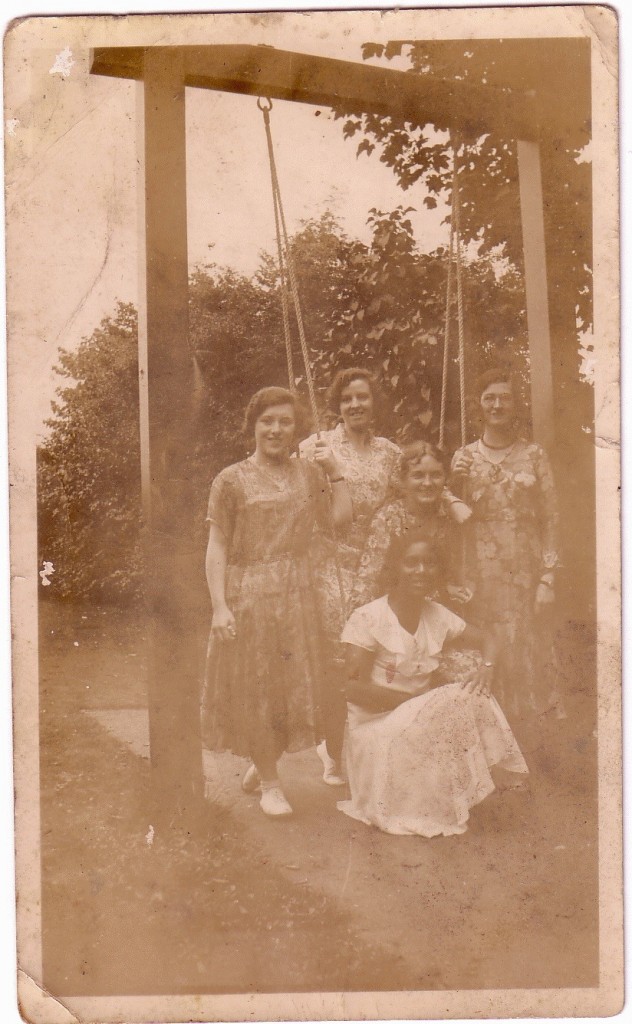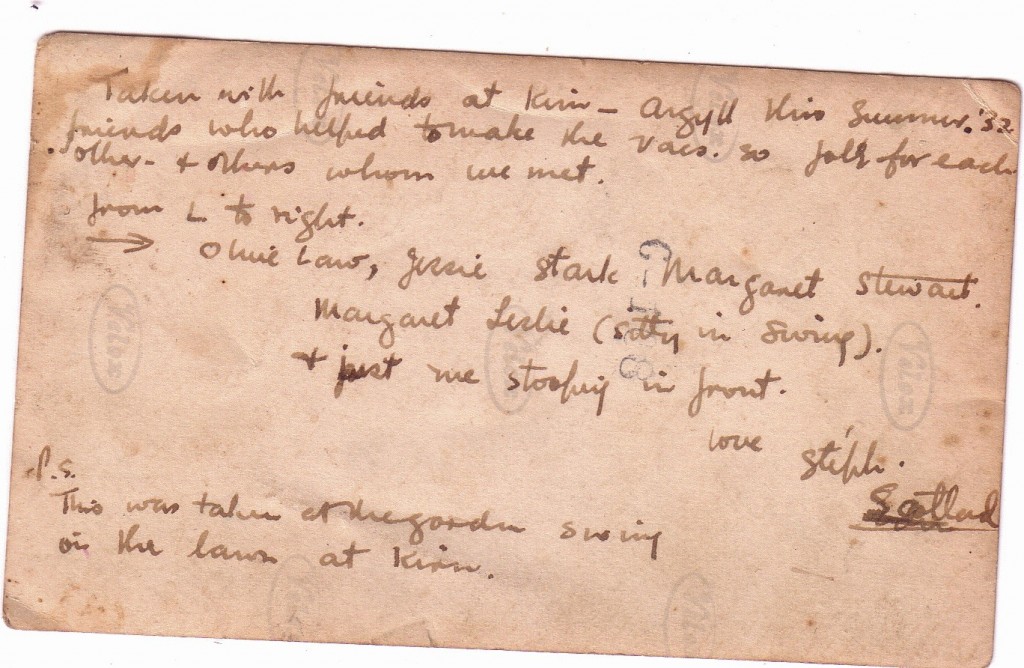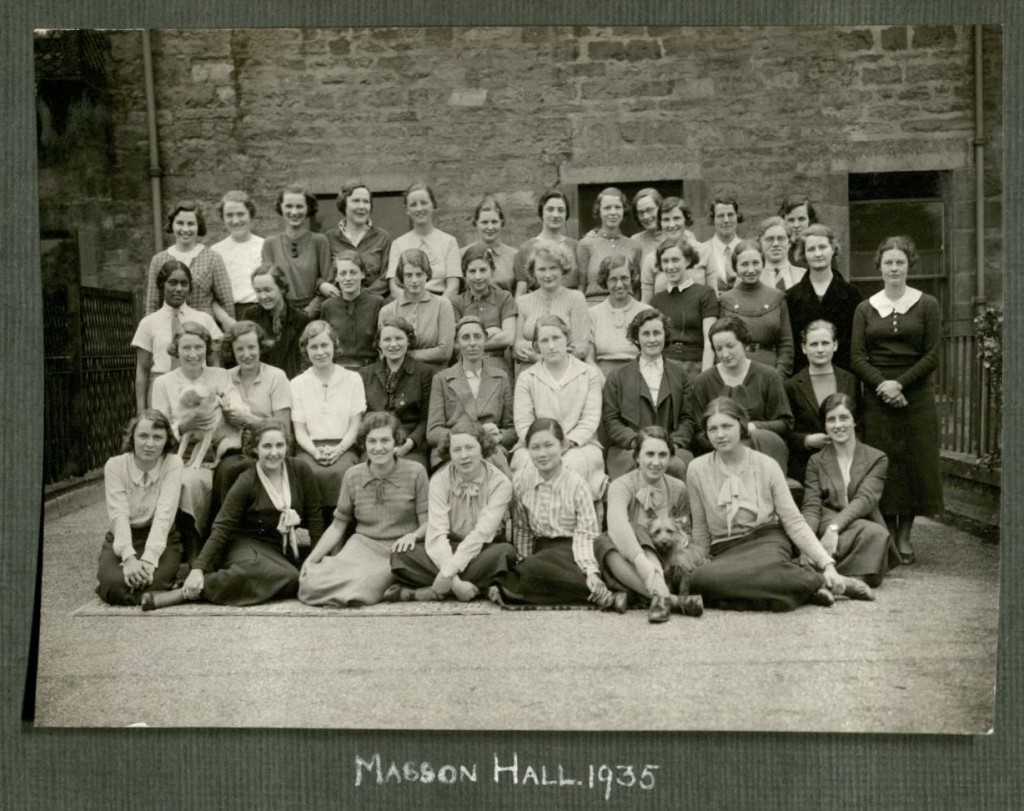THE BATTLE OF WATERLOO REFLECTED IN OUR ARCHIVE COLLECTIONS
 On Sunday 18 June 1815, on the muddy fields of Waterloo just outside Brussels in today’s Belgium, Napoleon Bonaparte with his French Imperial Guard faced off the Duke of Wellington and the British and Allied army. The course of the Battle of Waterloo, notable officers and men, and the battle outcome can all be referred to elsewhere. Instead, on this 200th anniversary of Waterloo, we focus on some of the material curated by the Centre for Research Collections which reflect these hours of 18 June 1815 and the aftermath of battle.
On Sunday 18 June 1815, on the muddy fields of Waterloo just outside Brussels in today’s Belgium, Napoleon Bonaparte with his French Imperial Guard faced off the Duke of Wellington and the British and Allied army. The course of the Battle of Waterloo, notable officers and men, and the battle outcome can all be referred to elsewhere. Instead, on this 200th anniversary of Waterloo, we focus on some of the material curated by the Centre for Research Collections which reflect these hours of 18 June 1815 and the aftermath of battle.
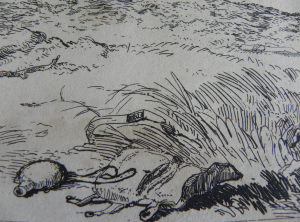
Drinking bottle and personal effects on the field of battle in scene No.7 of the Barker Panorama of Waterloo (produced in 1816), shown at Leicester Square, London. (Coll-1101 – Barker Panorama of Waterloo, CRC)
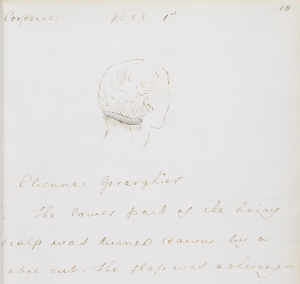
Wound sustained by Etienne Gerarghier during the Battle of Waterloo and appearing in the case-notes of Dr. Thomson and Dr. Somerville. (On p. 18 of Gen.594, in Coll-530 – Collection of sketches and reports of wounded at the Battle of Waterloo, CRC)
The collections profiled are: scenes from the panorama of the field of battle at Waterloo drawn by Henry Aston Barker (Coll-1101); and, sketches and reports by Dr. John Thomson and Dr. William Somerville of the wounded at Waterloo (Coll-535).
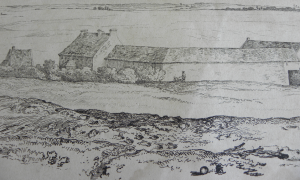
The farm of La Haye Sainte ‘where the Life Guards charged the Cuirassiers’ of the French Imperial Army (armour and firearm equipped cavalry). In part No.1 of the panorama. (Coll-1101 – Barker Panorama of Waterloo, CRC)
Firstly… scenes from the panorama of the field of battle at Waterloo (Coll-1101).
Henry Aston Barker (1774-1856) was the younger son of Robert Barker (1739-1806), the panorama painter. Aged 12, he was sent by his father to take outlines of Edinburgh from the city’s Calton Hill for the world’s first 360 degree exhibition panorama.
Barker panoramas were exhibited at an establishment in Castle Street, off Leicester Square, London, and the first was a view of London from the roof of the Albion Mills in 1791, the drawings for which were made by the young Henry. Later on, from 1793, Barker panoramas moved to the first purpose-built panorama building in the world, in Leicester Square itself.
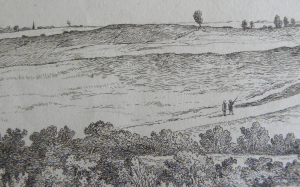
Scene showing the distant spire of Planchenoit (top left) ‘where Bonaparte slept the night before the Action’. In part No.2 of the panorama. (Coll-1101 – Barker Panorama of Waterloo, CRC)
The scenes for the panorama of the field of battle at Waterloo were drawn by Barker on the Plateau of Mont St. Jean, the escarpment which provided Napoleon’s name for the battle – La bataille de Mont-Saint-Jean.

Scene showing distant platform or scaffold (top left) ‘near which Bonaparte gave his orders in the early part of the Action’. In part No.3 of the panorama. (Coll-1101 – Barker Panorama of Waterloo, CRC)
Barker had also visited Paris to research the project and to interview officers who participated in the battle. The scenes were etched by J. Burnet, and they were produced in 1816 for sale to visitors to the panorama building at Leicester Square. The credit to both Burnet and Barker is printed on each of the eight components of the ‘souvenir’ panorama.
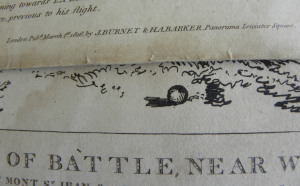
The drawings were initially done by Henry A. Barker, and then etchings were made by J. Burnet. (Coll-1101 – Barker Panorama of Waterloo, CRC)
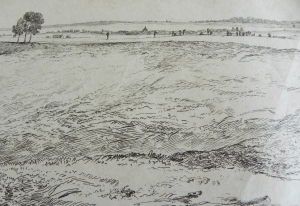
This scene showing the trees and field that approximately ‘mark the Right of the edge of the British position’. In part No.4 of the panorama. (Coll-1101 – Barker Panorama of Waterloo, CRC)
It was intended that the eight parts of the panorama be joined together to form a complete circle. The viewer would then stand in the centre and have a panoramic view of the entire scene of Battle.
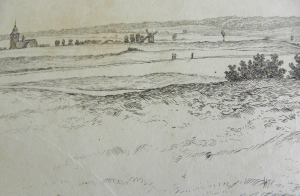
The church and windmill of the village of Braine La Leude on the battle site. In part No.5 of the panorama. (Coll-1101 – Barker Panorama of Waterloo, CRC)
Each component is around 60cm x 29cm in size and together they show principally: 1 -The farm at La Haye Saint; 2 – Around the orchard of La Haye Sainte; 3 – Prominent part of the Plateau of Mont St. Jean; 4 – The crest of the hill on which the Imperial Guards were charged; 5 – The village of Braine La Leude; 6 – The village of Mont St. Jean; 7 – The Forest of Soigne; and, 8 – Road and hedge leading to Ter La Haye.

Distant Dome of the Church of Waterloo in Brabant (Église Saint-Joseph de Waterloo) and the village of Mont St. Jean. In part No.6 of the panorama. (Coll-1101 – Barker Panorama of Waterloo, CRC)
At Waterloo, the French army of around 72,000 faced the outnumbering 113,000 allied British, Low Countries, German and Prussian forces. Napoleon lost around 25,000 men either killed or wounded, and 9,000 captured, while the allies lost around 23,000. Napoleon abdicated four days later.
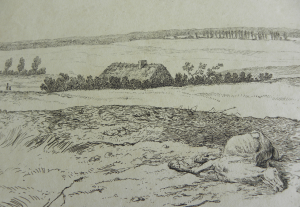
Part of the distant Forest of Soigne on the site of battle. In part No.7. of the panorama. (Coll-1101 – Barker Panorama of Waterloo, CRC)
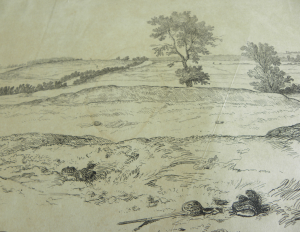
Scene showing personal effects on a part of the site ‘where the Highlanders suffered so severely’. In part No.8 of the panorama. (Coll-1101 – Barker Panorama of Waterloo)
So then… secondly… emphasising the human loss and injury… sketches and reports and case-notes of the wounded at Waterloo (Coll-535).
The wounds of French and Allied alike were described and reported on – as case-notes and sketches – by Dr John Thomson, Professor of Military Surgery at Edinburgh, and Dr William Somerville, the principal medical officer in Scotland. In the summer of 1814, Thomson had toured medical schools in France, Italy, Austria, Saxony, Prussia, Hanover and Holland, and in 1815 he was a staff-surgeon in Brabant and was at the Battle of Waterloo.

Wounds suffered by Jean Louis le Jeun who was cut with a sabre. (On p.21 of Gen.594, in Coll-535 – Collection of sketches and reports of wounded at the Battle of Waterloo, CRC)
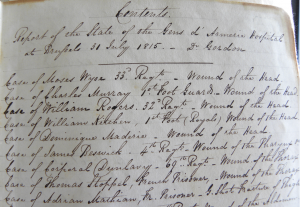
Contents pages at the beginning of the volume containing reports and cases at Gens d’Armerie Hospital in Brussels. (In the volume Gen.595, in Coll-535 – Collection of sketches and reports of wounded at the Battle of Waterloo, CRC)
The two-volume work profiled here was probably done in 1815. One also contains statistical tables of the wounded at the site – Reports cases and returns of the wounded at Waterloo (Gen. 595).

Index of the names of soldiers, description of wounds, and place of wounds, from the volume of sketches of the wounded. (In the volume Gen.594, in Coll-535 – Collection of sketches and reports of wounded at the Battle of Waterloo, CRC)
The other is illustrated with sketches of specific wounds of the soldiers, their names, their regiments, and details of their injuries – Sketches of the wounded at Waterloo. Drs. Thomson & Somerville (Gen. 594). Along with a number of other items both of the ‘Waterloo wounds’ volumes were transferred Edinburgh University Library from the Library of the Anatomical Museum, Edinburgh University, in June 1962.
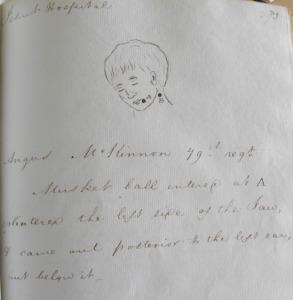
Description of the wounds suffered by Angus McKinnon (On p. 39 of Gen.594, in Coll-535 – Collection of sketches and reports of wounded at the Battle of Waterloo, CRC)

Description of the wounds suffered by Anton Wallenton (On p.49 of Gen.594, in Coll-535 – Collection of sketches and reports of wounded at the Battle of Waterloo, CRC)
The sketches show the kind of sabre wounds suffered by Etienne Gerarghier and Jean Louis le Jeun, and also wounds caused by firearms and cannon… e.g. the musket-ball wounds of Angus McKinnon, 79th Regiment, and the accidental wound of the German soldier Anton Wellonton. The sketches show the entry points at ‘A’ and the exit points at ‘B’.
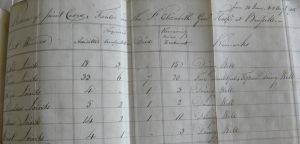
Return for joint cases treated at the St. Elisabeth General Hospital, Brussels, from 20 June to 5 August 1815. (From volume known as Gen.595, in Coll-535 – Collection of sketches and reports of wounded at the Battle of Waterloo, CRC))
In addition to the work of Thomson and Somerville, reports in the volumes have also been written by: J. Gordon, Surgeon to the Forces in charge of Gens d’Armerie Hospital; Henry Home Blackadder; J. Cole, Surgeon to the Forces; W. Blick, Surgeon to the Forces; Roderick MacLeod, Hospital Assistant; Charles Collier, Surgeon to the Forces; and J. Roche, Surgeon to the Forces; and others. The sketches and reports are of cases in several of the hospitals accommodating the wounded around Brussels – these being the Jesuits’, the Annonciate, Gens d’Armerie, and St. Elisabeth – and in Antwerp, at the Corderie and the Facon.
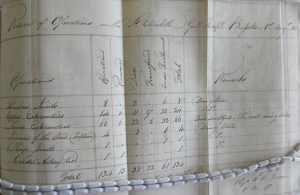
Return of operations performed at the St. Elisabeth General Hospital, Brussels, 1 August 1815. (From volume known as Gen.595, in Coll-535 – Collection of sketches and reports of wounded at the Battle of Waterloo, CRC)
Today in 2015, the battle site of Waterloo is a popular attraction for visitors to Brussels and to Belgium generally. The site is dominated by the artificial Butte du Lion created in the 1820s in the earliest days of Waterloo tourism and before the founding of modern Belgium. The Butte du Lion is an artificial earth-mound topped by a large giant sculpted lion commemorating the location where William II of the Netherlands, Prince of Orange, was knocked from his horse by a musket-ball to the shoulder during the battle.  Adjacent to the Butte and to the new tourist facilities built for the 200th anniversary, stands a panorama building offering a large vista of the events of 18 June 1815. The Waterloo panorama building was designed by Franz Van Ophem in 1911 for the then forthcoming 100th anniversary of the Battle. It houses a 360° panoramic oil-on-canvas painting completed by the French artist Louis-Jules Dumoulin in 1912.
Adjacent to the Butte and to the new tourist facilities built for the 200th anniversary, stands a panorama building offering a large vista of the events of 18 June 1815. The Waterloo panorama building was designed by Franz Van Ophem in 1911 for the then forthcoming 100th anniversary of the Battle. It houses a 360° panoramic oil-on-canvas painting completed by the French artist Louis-Jules Dumoulin in 1912.
 Dr. Graeme D. Eddie, Assistant Librarian Archives & Manuscripts, Centre for Research Collections
Dr. Graeme D. Eddie, Assistant Librarian Archives & Manuscripts, Centre for Research Collections
 This blog post was compiled with the help of some information contained on pp.307-308 of The Edinburgh professoriate 1790-1826 and the University’s contribution to nineteenth century British society. Anand Chidamber Chitnis. Ph.D. 1968. Edinburgh… and also on pp.39-50 of ‘British Medical Arrangements during the Waterloo Campaign’, by Colonel H. A. L. Howell, in Proceedings of the Royal Society of Medicine. (Sect. Hist. Med.). 1924 (17).
This blog post was compiled with the help of some information contained on pp.307-308 of The Edinburgh professoriate 1790-1826 and the University’s contribution to nineteenth century British society. Anand Chidamber Chitnis. Ph.D. 1968. Edinburgh… and also on pp.39-50 of ‘British Medical Arrangements during the Waterloo Campaign’, by Colonel H. A. L. Howell, in Proceedings of the Royal Society of Medicine. (Sect. Hist. Med.). 1924 (17).

